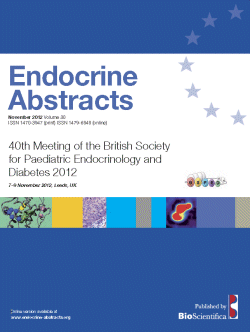Searchable abstracts of presentations at key conferences in endocrinology

40th Meeting of the British Society for Paediatric Endocrinology and Diabetes
Oral Communications
Oral Communications 5
ea0030oc5.1 | Oral Communications 5 | BSPED2012
Adolescent transition clinic: a review of the young person's self-confidence and future concerns
Whitehead A , Walker J , Mushtaq T , Alvi N S
Introduction: There has been a joint transition clinic in our tertiary centre for over 10 years. We have recently undertaken a questionnaire based review of this service.Methodology: The questionnaire comprised two components: what the young adults understood about their condition and the medications they were currently taking using both a written response and a score of 010 for how confident they felt in this. They were also asked to complete a co...
ea0030oc5.2 | Oral Communications 5 | BSPED2012
Comparison of patient experiences of the glucagon and insulin pituitary provocation tests: time for a reappraisal
Katugampola Harshini , Bulwer Chloe , Spoudeas Helen A
Introduction: The debate surrounding the most suitable pituitary provocation test in children is controversial. There is a perception that the gold standard insulin tolerance test (ITT) is dangerous and that the glucagon stimulation test (GST) is safer and a more tolerable alternative, particularly in younger children. There have been no reports in the literature comparing patient experiences of these tests.Aim: To examine the tol...
ea0030oc5.3 | Oral Communications 5 | BSPED2012
A comparison of patient's preferences for attributes of GH delivery devices: children starting versus children established on GH treatment
Yaw Stephanie How , Mushtaq Talat , Alvi N S , Walker Jenny , Whitehead Amanda
Background: Several devices are available for the administration of recombinant GH. A prospective study was undertaken to look at those attributes of GH delivery device most important to patients when making their choice.Objectives: i) To understand which features of a GH device are considered most important to patients when choosing a device. ii) Comparison of patients device preferences at start of GH treatment and after 2 years of treatment. iii...
ea0030oc5.4 | Oral Communications 5 | BSPED2012
The role of the paediatric endocrine nurse in supporting the information needs of girls with Turner syndrome and their parents
Aim: To explore the role of paediatric endocrine nurse specialists in supporting information needs of girls with TS and their parents.Methods: A purposive sample of 15 families with daughters aged 916 years were recruited from a tertiary paediatric growth clinic to participate in an exploratory qualitative study. 27 semi-structured interviews were recorded. Data were analysed using the framework approach and constant comparative method. Analysis re...



